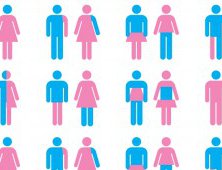
Men and women come with different but innately defined social roles. From the moment a child is born, we follow the custom of fitting the infant within one of the binaries. The child is molded to be either masculine or feminine depending on the gender; male and female. As today we notice the positive inclination towards gender equality, the growing LGBTQ scenarios as well as acceptance of individuality, are we unaware that gender may not be a binary or do we conveniently ignore it?
We have always been oblivious to the possibility of multiple genders as our culture enforces us to believe that there exist only two sexes. As mentioned by Dr. Anne Fausto Sterling, the concept of intersexual bodies have been studied upon with great interest by medical professionals and within this category lie three other subgroups, characteristic of a mixture of both male and female biological features. Hermaphrodites (Herms) are individuals with one testis and one ovary whereas the male pseudohermaphrodites (Merms) possess testis no ovaries but some aspects of the female body and female pseudohermaphrodites (Ferms) with one ovary and minor male features but no testis. Most intersexual undergo a surgery to be either male or female at birth as otherwise the ‘deformed’ child will have a difficult time fitting into the society. While science justifies the possibility of the intersexual to survive the way they were born, our culture needs the distinction between just two sexes. Prior to considering any of these possibilities such as the peaceful existence of other genders, there are a lot of things we need to be open and accepting about. These issues such as intersexuality and homosexuality maybe be difficult to deal with in a society that still shuns away the act of sex, as if it doesn’t exist.
Our acceptance of differences and deviations may be improving each day but it is imperative to realize that we often reduce an individual's choices or behaviours as one's identity. Along the lines of Judith Butler, I urge all of us to think that gender may not be an identity but a series of our socially constructed behaviours. Similarly, being lesbian, gay or transgender is just a choice or performance and not somebody’s identity. We all should be given a free choice of deciding how we wish to identify ourselves rather than letting someone else assume their rights to label us. As I read about the Mati Work amongst the Creole working class women in Suriname I realised the problematic western embedded notion of homosexuality that we are trapped within. Mati in Suriname are women who have sex with both men and women, consecutively or simultaneously. These women maybe married to men with children but they form close sexual bonds with their female friends too. They usually share a transactional relationship with men but prefer to be involved more with women. Their relationship with males isn't always due to the economic factor; for instance the young Mati women who are economically independent may need to be sexually involved with a man in order to gain the status of motherhood that she highly values. The Mati work stems from their Winti religion that carries the belief of an individual being composed of two deities, the male and female. As the male god may get jealous of these woman being involved with another man, the religion itself justifies Mati work for them. This kind of religious explanation is also important as it is an alternative to the hegemonic western definition of homosexuality that we assume is absolute.
As I’d like all of us to embrace these possible scenarios such as the ones I’ve mentioned above, I do realize that the transition from traditional beliefs will not be without friction. However, I’d like to think about the agency each one of us deserves to have over our lives. Even within the society’s dichotomous gender category, several variations exist with some women being more hairy and others broad chested whereas some men may have less facial hair. Similarly, the intersex individuals are people simply with variations in genitals and we must accept our gender diverse world. Our society is far from accepting these multi-gender situations as while we do consider the existence of the third gender today, we still officially term them as the ‘other’. Our language itself limits their peaceful existence and instills in them a fear of transgression. While the males can be referred to as he/him and females as her/she, how do we address the others? Why is it necessary to ‘come out of the closet’ if you wish to sexually be involved with the person from the same gender but not the opposite? Change may seem like a challenge but we could always start small. So, instead of readily accepting these absurd societal rules maybe it is time we question them and try changing the way we perceive things.

Shreya Gyawali
Gyawali is a student
- Could Nepal Be The Next Technology Destination? A Conversation With Karvika Thapa, CEO Kimbu Tech
- Sep 02, 2021
- Remembering The Great Nationalist Leader: Kriti Nidhi Bista
- Dec 08, 2018
- An Atempt At Feminism
- Sep 22, 2018
- Nora Raymond: The Journey Upto 97 Years And More!
- Jul 21, 2018
- Anthropology Today
- Mar 09, 2018












